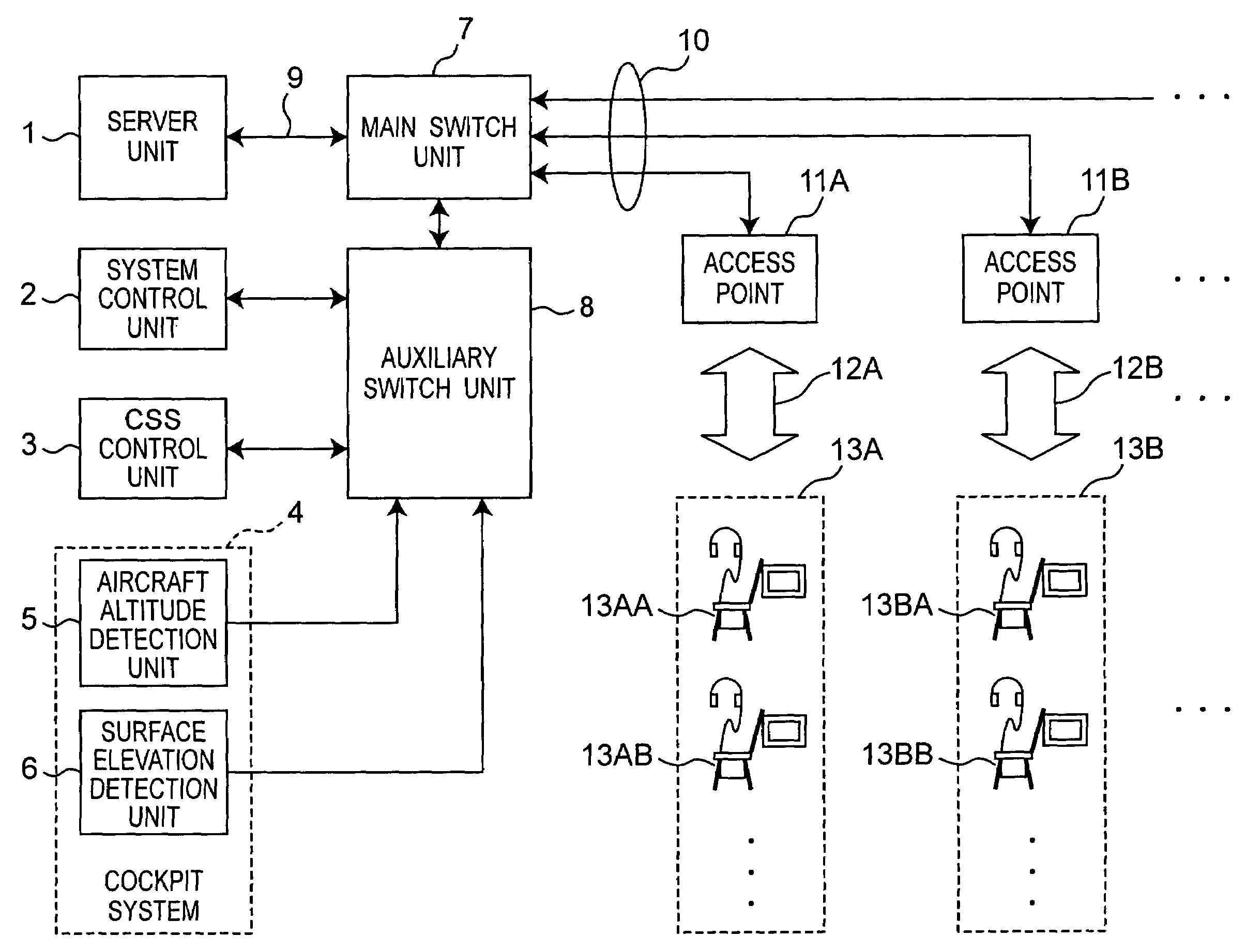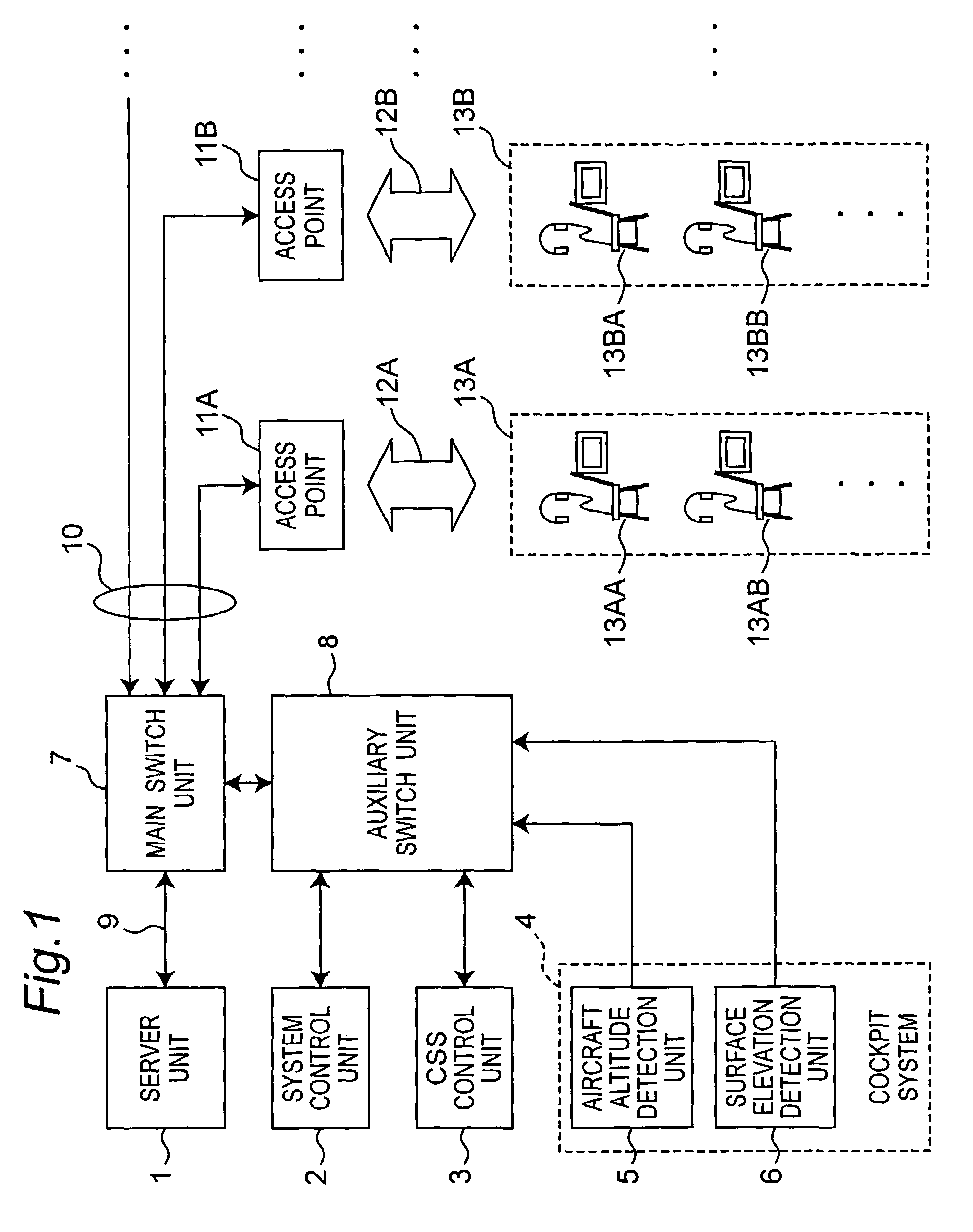Wireless transmission system and method for wirelessly transmitting data signals in a flight vehicle
a transmission system and flight vehicle technology, applied in the direction of transmission monitoring, wireless commuication services, aircraft crew accommodation, etc., to achieve the effect of reducing the cost of changing the seating configuration, facilitating the change of seating configuration, and improving the in-service rate of the aircra
- Summary
- Abstract
- Description
- Claims
- Application Information
AI Technical Summary
Benefits of technology
Problems solved by technology
Method used
Image
Examples
first embodiment
[0031]FIG. 1 is a block diagram showing the general arrangement of the first embodiment of the invention. This first embodiment of the invention is installed inside an aircraft. The aircraft may be an airplane with jet engines or propellers, for example, a helicopter, a hovercraft, a balloon tethered to the ground, a rocket, a man-made satellite, a space station, or any other type of craft that can remain aloft at a predetermined distance or more from the Earth's surface for at least a predetermined period of time. This first embodiment of the invention is described using a passenger plane by way of example only. There may be several hundred passenger seats installed in the airplane, and passengers can enjoy movies, audio programming, games, and Internet browsing by an in-flight entertainment (IFE) system.
[0032]Referring to FIG. 1, the server unit 1 includes a hard disk array for storing data signals including at least one of a video signal or an audio signal, and an AV server for r...
second embodiment
[0097]This second embodiment of the invention differs from the first embodiment in the allocation of wireless channels as further described below. Other aspects of the arrangement, operation, and effect of this second embodiment are the same as the first embodiment, and further description thereof is thus omitted.
[0098]FIG. 6A and FIG. 6B describe different methods of allocating the wireless channels shown in FIG. 4 to different parts of the airplane. The arrangements shown in FIG. 6A and FIG. 6B differ from the arrangements shown in FIG. 5A and FIG. 5B only in that the wireless zones indicated by dotted lines and the wireless channel allocated to each wireless zone are different.
[0099]FIG. 6A shows the zone and channel allocation when in the first altitude zone, at which time the wireless channels C36, C44, C40, and C48 in the F1 frequency band are allocated for first service use. The first services must normally be delivered to all parts of the airplane, and the same content is di...
third embodiment
[0101]The allocation of wireless channels in this third embodiment differs from the allocation in the first and second embodiments. Other aspects of the arrangement, operation, and effect of this second embodiment are the same as the first embodiment, and further description thereof is thus omitted.
[0102]FIG. 9A and FIG. 9B describe another method of allocating the wireless channels shown in FIG. 4 to different parts of the airplane. The arrangements shown in FIG. 9A and FIG. 9B differ from the arrangements shown in FIG. 5A and FIG. 5B only in that the wireless zones indicated by dotted lines and the wireless channel allocated to each wireless zone are different.
[0103]FIG. 9A shows the zone and channel allocation when in the first altitude zone, at which time the wireless channel C36 in the F1 frequency band is allocated for first service use. Wireless channel C36 is suited for use with the first services because the first services must be provided throughout the aircraft and wirele...
PUM
 Login to View More
Login to View More Abstract
Description
Claims
Application Information
 Login to View More
Login to View More - R&D
- Intellectual Property
- Life Sciences
- Materials
- Tech Scout
- Unparalleled Data Quality
- Higher Quality Content
- 60% Fewer Hallucinations
Browse by: Latest US Patents, China's latest patents, Technical Efficacy Thesaurus, Application Domain, Technology Topic, Popular Technical Reports.
© 2025 PatSnap. All rights reserved.Legal|Privacy policy|Modern Slavery Act Transparency Statement|Sitemap|About US| Contact US: help@patsnap.com



